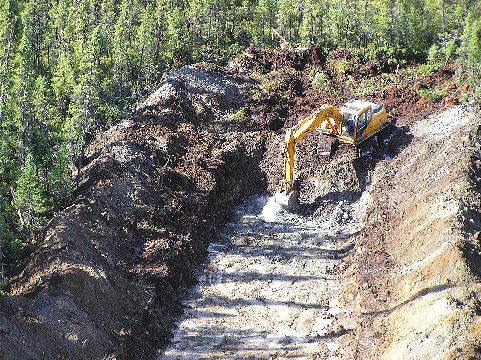With gold finding comfort above the US$400-per-oz. level, it was just a matter of time before exploration dollars found their way back to the Pickle Lake gold camp of northwestern Ontario.
Pickle Lake received a lot of attention in the mid-1980s when the gold price was high and flow-through financing was available to any company that could track down an unoccupied drill rig. Noramco Exploration, in particular, boasting a flow-through treasury in the tens of millions of dollars, focused much of its spending on the camp.
But when the federal government scrapped the mining exploration depletion allowance in 1988 and the gold price dropped, Pickle Lake went into retreat. The Dona Lake mine, discovered in 1980 by Dome Exploration, closed in 1993 after producing 218,868 oz. gold.
Now, after a long hiatus, several juniors are staking ground in the area, hopeful that more gold can be found in the historic camp. Once again, flow-through financing is providing the means.
“It’s very accessible and has a long history of production, and we feel that there’s a lot more to be found there.” says Aubrey Eveleigh, vice-president of exploration for
Gold was discovered in the Pickle Lake area in 1928, and a subsequent staking rush led to the discovery of the Central Patricia and Pickle Crow Mines. Central Patricia produced 608,650 oz. gold at a grade of 0.35 oz. per ton from 1934 to 1951. Pickle Crow, the longest-lasting and largest producer in the camp, yielded 1.45 million oz. gold at a grade of 0.47 oz. per ton from 1935 to 1966.
Another wave of exploration hit the area in the 1980s after the discovery of the Dona Lake mine and, farther west, Golden Patricia.
The Pickle Lake greenstone belt is one of several metavolcanic-metasedimentary belts, including Rice Lake and Red Lake, that crisscross the Uchi Sub-province. The metavolcanic rocks consist of flows and pyroclastic units that range in composition from mafic to intermediate to felsic. The metasedimentary rocks are made up of clastic units and iron formation.
Gold deposits in the area consist of a mixture of composite quartz veins, vein stockworks and replacement bodies in banded iron formation and silicified shear zones, according to Resident Geologist Mark Smyk. Noramco’s exploration in the 1980s also targeted deformed and altered porphyries. Grades tend to be high in the quartz veins but low to moderate over wider widths in the stockworks, shear zones, and replacement bodies.
Structurally, the belt has been folded into a series of anticlines and synclines and cut by large-scale faults that typically parallel the local schistosity and major fold axes. Gold mineralization is commonly found in the noses of folded iron formations.
Although majors are not currently active in the region, several juniors are attempting to trace the elusive gold targets at depth.
MetalCorp recently wrapped up a drilling program on its Metcalfe property, one of three contiguous properties along a major northeast-trending deformation zone that contains significant gold occurrences over a strike length of 12 km.
Although surface channel samples of quartz veins from Metcalfe’s three main zones returned high grades (for example, 34 grams gold per tonne over 0.12 metre, 107 grams over 0.1 metre, and 4.59 grams over 1.6 metres), the 6-hole program yielded lower-grade intersections at depth. Future drilling will target the Carbonate zone, which yielded intersections of up to 1.1 grams over 12 metres in strongly altered volcanics at depths of 64-99 metres.
The largest landholder in the area is
The $500,000 program will include more than 3,000 metres of drilling by King’s Bay, which has its own drill rigs and other heavy equipment. The junior holds most of the ground in the triangle of land that includes the Dona Lake, Central Patricia and Pickle Crow mines.
Richview has also teamed up with
Other operators in the vicinity include
— The author is a Toronto-based geologist and writer specializing in mining and the environment. Her website is www.geopen.com


Be the first to comment on "Growing traffic in Pickle Lake camp"